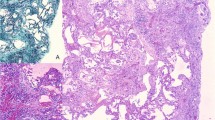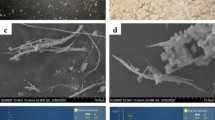Summary
Substantiation of relevant asbestos risks by microscopic examination sets a lower detection limit at fibres longer than 5 to 10 μm and thicker than 0.5 μm Such microscopically detectable fibres are, of course, in respect to “total quantity” the insignificant part of the overall dust burden, but apparently a necessary part of the whole fraction when assessing the relevance of exposure. Until now, no epidemiologically conclusive asbestos risks resulting from occupational exposure have been made known solely with fibre fraction below the microscopic detection limit. Demands for supplementary electromicroscopic examination on the basis of case reports of lung parenchyma damage by fibres of a lower calibre than the microscopic detection limit are, therefore, presently without foundation. The subject examinations reveal that substantiation of asbestos risks with light-optical means, using different methods, provides comparable results. Initially, of course, it is surprising to obtain fluctuations in results of 100000 to 600000 asbestos particles for the same case. However, one must realize that calculations based on intermediate results are responsible for this range of fluctuation, due to the varying degree of asbestos fibre dispersion in the different sections of the lung and, depending on the method of detection used. Interest on the part of everyday occupational medicine and expert opinion is determined by the need to categorize individual cases into different basic classes of risk by referring to relevant morphological facts, such as substantiation of asbestosis or drawing a borderline between persons with occupational risk and those with a non-occupational risk. The subject examinations reveal, using different methods of analysis, equally significant results, which correspond with those published by other authors who used a method which, in terms of expenditure for material and manpower, is also suitable for routine analysis.
Similar content being viewed by others
References
Ashcroft T, Heppleston AG (1973) The optical and electron microscopic determination and pulmonary asbestose fibre concentration and its relation to the human pathological reaction. J Clin Pathol 26:224
Bignon J, Sebastien P (1974) Microfiltration method for quantitative study of fibrous particles in biological specimens. Environ Health Persp 9:155–160
Churg A (1982) Fibre counting and analysis in the diagnosis of asbestos-related disease. Hum Pathol 4;13:381–382
Einbrodt HJ (1967) Fortschritte in der Forschung anderer Pneumokoniosen außer Silikose. Fortschr Staublungenforsch 2:475–480
Eitner F, Otto H (1984) Zur Dignität von Asbestkörper-chenzählungen im Lungengewebe. Arbeitsmed Sozialmed Präventivmed 19:1–5
Otto H (1963) Morphologie and Pathologie. — Anatomische Begutachtung der Silikose. Grasser, Würzburg
Sebastian P, Fondimare A, Bignon J (1977) Topografic distribution of asbestos fibres in human lung in relation to occupational and nonoccupational exposure. In: Walton WH, McGovern B (eds) Inhaled particles IV, part 2. New York, Pergamon Press, p 435
Thomas K, Stegmann H (1954) Isolierung und Eigenschaften der Fremdstäube aus Lungen. Staublungenerkrankungen 2:172–176
Whitwell F, Scott J, Grimshaw M (1977) Relationship between occupations and asbestos-fibre content of the lungs in patients with pleural mesothelioma; Lung cancer and other diseases. Thorax 32:377
Zeeh J, Eitner F, Otto H (1986) Zum Stellenwert der Anamnese zur Ermittlung einer Asbestgefährdung. Arbeitsmed Sozialmed Praventivmed 21:1–4
Author information
Authors and Affiliations
Rights and permissions
About this article
Cite this article
Eitner, F. Substantiating hazardous exposure to asbestos by examination of pulmonary dust. Int. Arch Occup Environ Heath 61, 163–166 (1988). https://doi.org/10.1007/BF00381013
Received:
Accepted:
Issue Date:
DOI: https://doi.org/10.1007/BF00381013




